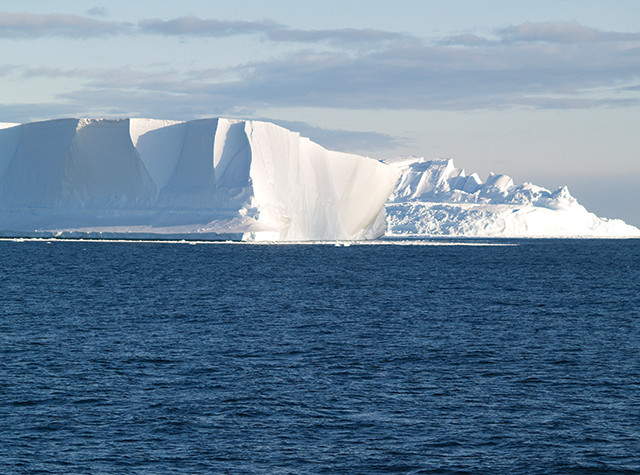
by Mary Caperton Morton Monday, May 9, 2016

Dozens of giant icebergs are currently floating in the Southern Ocean, with more projected to calve in the coming years. Credit: Patrick Rowe, National Science Foundation.
A new study shows that giant icebergs floating in the Southern Ocean around Antarctica may be playing a larger role in carbon sequestration and Earth’s global carbon cycle than previously thought.
By studying satellite images of the Southern Ocean taken between 2003 and 2013, Grant Bigg of the University of Sheffield in England and colleagues found that drifting icebergs left a trail of enhanced phytoplankton activity at the ocean surface for as long as a month after they passed. The resulting plankton blooms could stretch for hundreds of kilometers.
As floating icebergs melt, they release iron and other nutrients stored in the ice, boosting phytoplankton growth in their wake. Phytoplankton are formidable agents of carbon sequestration, taking up carbon dioxide through photosynthesis and storing it in their calcium carbonate shells. When the microorganisms die — or after they are consumed and subsequently excreted by whales and other sea life — they sink to the seafloor, where much of the carbon is stored long-term in marine sediments.
The Southern Ocean is thought to be responsible for about 10 percent of the ocean’s total carbon sequestration through both biological and chemical processes. In the study, published in Nature Geoscience, scientists tracked dozens of icebergs that were longer than 18 kilometers; these behemoths may be responsible for up to 20 percent of the total carbon sequestered in the Southern Ocean, Bigg’s team estimated.
The new study sheds light on how Earth’s carbon cycle might be affected in the future, as massive icebergs continue to calve off of the Antarctic Ice Sheet. “If giant iceberg calving increases this century as expected, this negative feedback on the carbon cycle may become more important than we previously thought,” Bigg said in a statement.
© 2008-2021. All rights reserved. Any copying, redistribution or retransmission of any of the contents of this service without the expressed written permission of the American Geosciences Institute is expressly prohibited. Click here for all copyright requests.